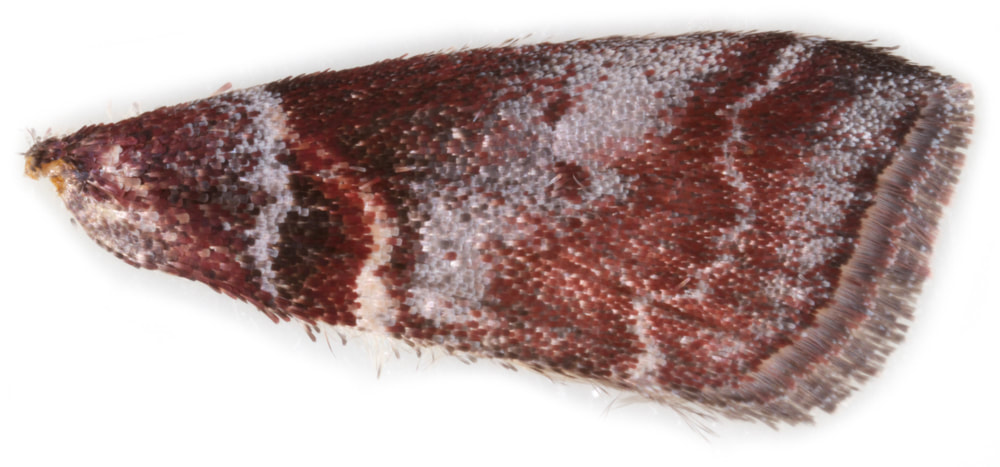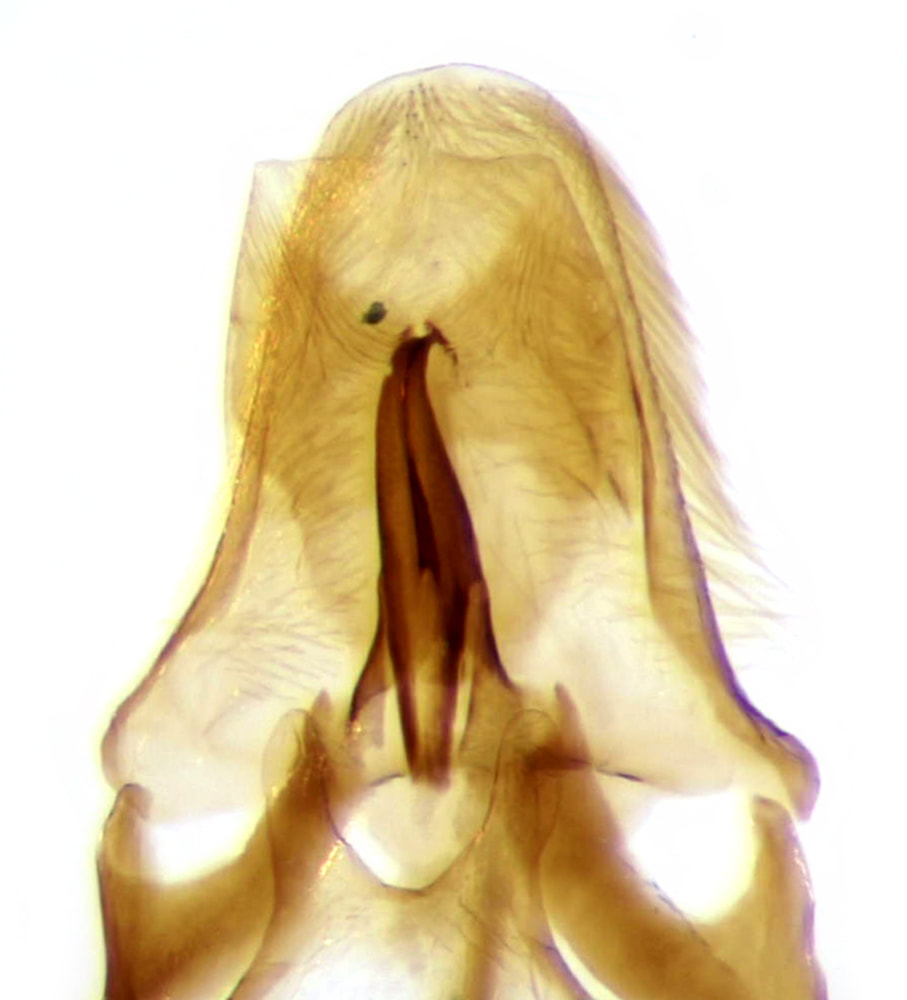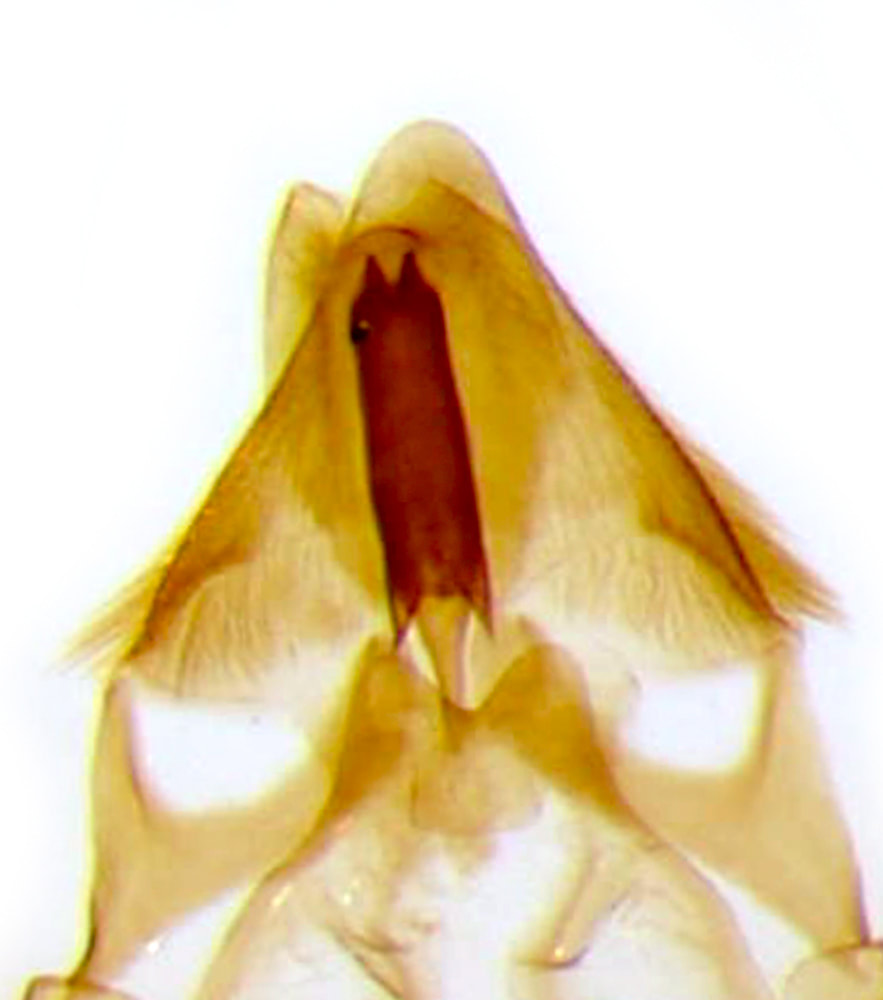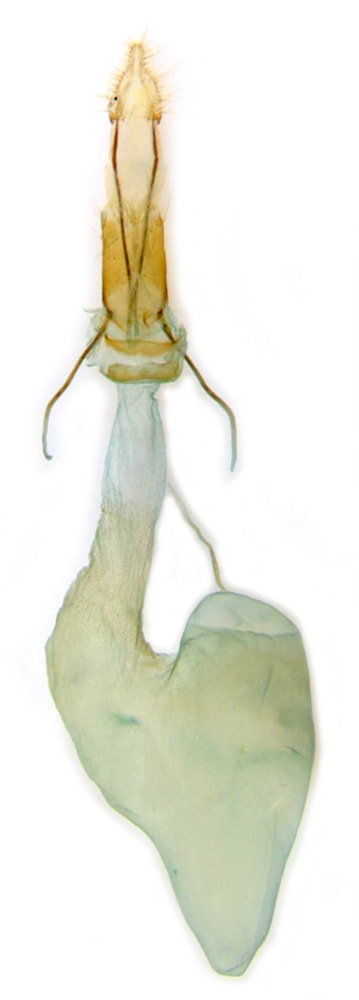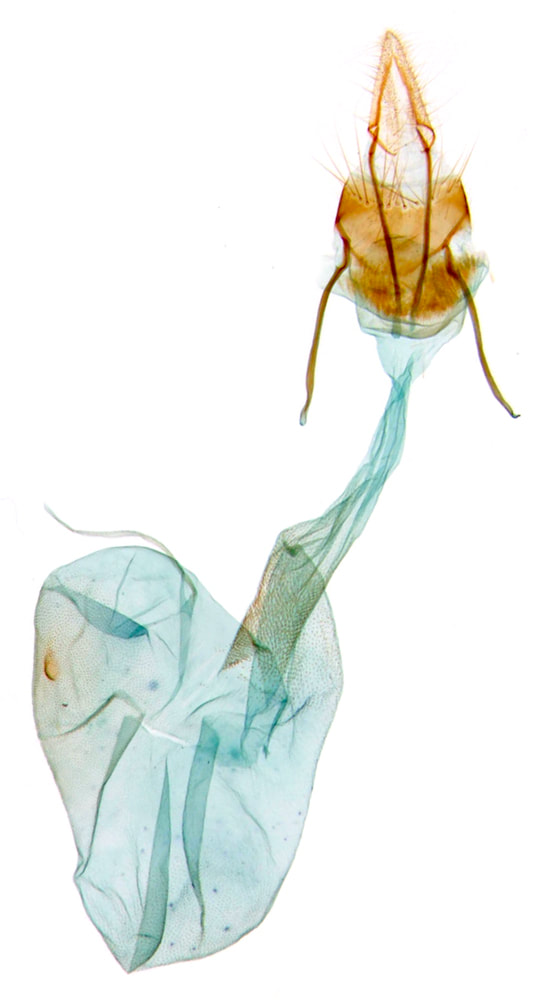|
Acrobasis
|
KEY - Forewing features |
|||
Antemedian white line strong and straight |
Ridge of raised scales proximal to antemedian line |
A.tumidana |
|
Basal area of forewing pink |
A.repandana |
||
Basal area of forewing grey |
A.consociella |
||
Antemedian white line arched |
Antemedian line approaches dorsum obliquely |
A.suavella |
Discal dots strong, black, transverse. Base of wing redder than head |
Reddish wedge between antemedian line and a more proximal transverse white line |
A.advenella |
Discal dots reddish oblique, often indistinct. Head redder than base of wing |
|
Whole wing base reddish/crimson |
A.marmorea |
Discal dots black, touching, slightly oblique. Apex rounded. Head and base of wing both red. |
Acrobasis species are quite similar. All show some admixture of red (ranging from pinkish to deep crimson), and grey (ranging from mid-grey to black); a white/whitish more or less transverse and usually predominantly straight antemedian line which shows a more-or-less distinct turn towards the wing base as it approaches the costa; a pale more-or-less sinuate-dentate post-median line (which is placed sufficiently distally as to be almost subterminal); and a pair of blackish discal dots. There is substantial intra-specific variation in the extent of any reddish suffusion, and the redder colours fade with wear. All are similarly sized, fly mainly in July-August (but can be found from June to September) and come readily to light. All, except A.tumidana, are at least locally common in south England; all except A.advenella are largely absent from Scotland.
ws (mm)* |
fw (mm)**/ª |
flight |
lfp |
status |
distribution |
|
A.tumidana |
19-24 |
na / 9.8-10.0 (2) |
Jul-Aug |
oak |
scarce resident / migrant |
S&SE England |
A.repandana |
20-25 |
9-11 / 9.3-10.4 (5) |
Jul-Aug |
oak |
common |
England, Wales |
A.advenella |
18-24 |
9-10 / 9.5-10.4 (6) |
Jul-Aug |
hawthorn, rowan |
common |
All GB |
A.suavella |
22-24 |
10-12 / 9.2-11.1 (3) |
Jul-Aug |
blackthorn |
local |
S.England, S.Wales |
A.marmorea |
18-23 |
8-10 / 9.2-10.0 (3) |
Jul-aug |
blackthorn |
local |
England, Wales |
A.consociella |
19-22 |
9-11 / 8.8-10.3 (4) |
Jul-Aug |
oak |
common |
England, Wales |
* Goater. ** Sterling & Parsons. ª My specimens
Males can be segregated into two groups of three species by the presence of a horny scale-tooth on the antennal scape in A.tumidana, A.repandana and A.consociella and its absence in A.advenella, A.suavella and A.marmorea
Forewing
A.repandana and A.consociella also have a strong straight white antemedian line. They differ from each other in the colour of the forewing proximal to this line - fairly uniformly pink in A.repandana predominantly grey, though often with some red/pink admixture in A.consociella.
In A.advenella, A.suavella and A.marmorea the antemedian line turns towards the base from midwing as it approaches the costa, giving the line a more arched appearance. These three species can be very similar and hard to differentiate with confidence on external features.
A.suavella can be distinguished by the antemedian line approaching the dorsum obliquely and being of fairly even strength throughout - In A.advenella and A.marmorea the antemedian line approaches the dorsum at 90° and is much stronger in its dorsal half. A.suavella usually shows strong discal dots equidistant from the wing base.
In A.marmorea the forewing is blunter at the apex and the costa straighter than in A.advenella or A.suavella and the discal dots somewhat oblique and usually touching or fused.
In A.advenella the discal dots are obliquely placed with the costal dot slightly proximal to the more dorsal dot. In my experience these dots are usually reddish or indistinct in A.advenella, but consistently black in A.suavella and A.marmorea.
In A.advenella and A.suavella there is a more-or-less distinct wedge of reddish proximal to the antemedian line, broader at the dorsum narrowing towards the costa. In A.advenella this wedge is often delineated proximally by a narrow white line that reaches the costa, so that the wedge appears to extend most of the way across the wing. In A.suavella the costal end of the wedge is around the middle of the wing. According to Goater the wedge is delineated by a white line that cuts the antemedian line at mid-wing, but I have not yet found the white line to be present in any specimen of A.suavella. In A.marmorea the whole wing base is usually reddish so that no distinct reddish wedge can be discerned.
The costal end of the postmedian line is bordered proximally by a narrow black margin that extends for a variable distance along the postmedian line and distally by a broader apical black patch. These black markings are usually distinct in A.suavella and A.marmorea but poorly marked in A.advenella.
Another feature I have noted is that the terminal interneural dots are discrete in A.suavella and usually so in A.marmorea, but confluent to form an irregular dark line in A.advenella.
In A.marmorea the forewing is blunter at the apex and the costa straighter than in A.advenella or A.suavella and the discal dots somewhat oblique and usually touching or fused.
In A.advenella the discal dots are obliquely placed with the costal dot slightly proximal to the more dorsal dot. In my experience these dots are usually reddish or indistinct in A.advenella, but consistently black in A.suavella and A.marmorea.
In A.advenella and A.suavella there is a more-or-less distinct wedge of reddish proximal to the antemedian line, broader at the dorsum narrowing towards the costa. In A.advenella this wedge is often delineated proximally by a narrow white line that reaches the costa, so that the wedge appears to extend most of the way across the wing. In A.suavella the costal end of the wedge is around the middle of the wing. According to Goater the wedge is delineated by a white line that cuts the antemedian line at mid-wing, but I have not yet found the white line to be present in any specimen of A.suavella. In A.marmorea the whole wing base is usually reddish so that no distinct reddish wedge can be discerned.
The costal end of the postmedian line is bordered proximally by a narrow black margin that extends for a variable distance along the postmedian line and distally by a broader apical black patch. These black markings are usually distinct in A.suavella and A.marmorea but poorly marked in A.advenella.
Another feature I have noted is that the terminal interneural dots are discrete in A.suavella and usually so in A.marmorea, but confluent to form an irregular dark line in A.advenella.
Other external features:
The head and patagia of A.advenella are usually red/crimson and contrast with the grey wing base; the head of A.suavella usually contrasts in the opposite direction - the wing-base being redder than the head; in A.marmorea the head, patagia and wing-base are usually concolorous, red.
(A.advenella shows a tuft of hair scales at the base of the midtibia in the male at least, which I have not observed in other Acrobasis species).
The head and patagia of A.advenella are usually red/crimson and contrast with the grey wing base; the head of A.suavella usually contrasts in the opposite direction - the wing-base being redder than the head; in A.marmorea the head, patagia and wing-base are usually concolorous, red.
(A.advenella shows a tuft of hair scales at the base of the midtibia in the male at least, which I have not observed in other Acrobasis species).
Male genitalia:
Acrobasis species differ mostly in features of the gnathos. The anellus/juxta is produced dorsally as a notched plate and ventrally as a pair of sclerotised lobes - there are inter-specific differences in the shape of these ventral lobes.
Acrobasis species differ mostly in features of the gnathos. The anellus/juxta is produced dorsally as a notched plate and ventrally as a pair of sclerotised lobes - there are inter-specific differences in the shape of these ventral lobes.
|
A.tumidana and A.repandana have a similarly shaped gnathos tapering towards the apex which is curved through ~90° to point at the uncus. Comparing images at Moth Dissection, they differ in the shape of the ventral juxta lobes which taper to a rounded apex in A.tumidana and narrow somewhat in the middle and expand at the apex in A.repandana.
Right: A.repandana - gnathos Far right: A.repandana - juxta lobes Below: A.repandana - genitalia, aedeagus removed |
In A.advenella the gnathos shows a ventral groove extending most of its length and is bifid from the apex for a variable length along this groove.
In A.suavella the gnathos bulges in the middle and then narrows to a truncate apex.
In A.marmorea the gnathos is broad-based and gradually narrows towards the apex (the images here shows a more abrupt narrowing than those at Moth Dissection)
In A.suavella the gnathos bulges in the middle and then narrows to a truncate apex.
In A.marmorea the gnathos is broad-based and gradually narrows towards the apex (the images here shows a more abrupt narrowing than those at Moth Dissection)
Female genitalia:
All Acrobasis species show spiculation of the anterior portion of the ductus bursae to its junction with the corpus bursae and all except A.advenella have a small scobinate signum in the corpus bursae. There is also some sclerotisation in the antral region and it seems that A.repandana (and maybe A.consociella) is distinct in having a more extensive sclerotisation here. A.consociella appears to be distinct in having a noticeably short (transverse) A8 this being quadrate to elongate in the other species. Based only on comparing my image of A.tumidana with those of other Acrobasis species here and at Moth Dissection, it is possible that the ductus bursae of A.tumidana is more uniformly narrow. I have not yet established any means of distinguishing A.suavella and A.marmorea on female genital features. More work needed.
All Acrobasis species show spiculation of the anterior portion of the ductus bursae to its junction with the corpus bursae and all except A.advenella have a small scobinate signum in the corpus bursae. There is also some sclerotisation in the antral region and it seems that A.repandana (and maybe A.consociella) is distinct in having a more extensive sclerotisation here. A.consociella appears to be distinct in having a noticeably short (transverse) A8 this being quadrate to elongate in the other species. Based only on comparing my image of A.tumidana with those of other Acrobasis species here and at Moth Dissection, it is possible that the ductus bursae of A.tumidana is more uniformly narrow. I have not yet established any means of distinguishing A.suavella and A.marmorea on female genital features. More work needed.
Page published 24/02/2020










